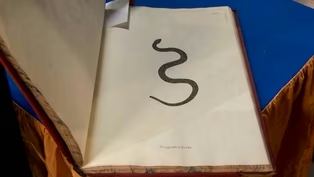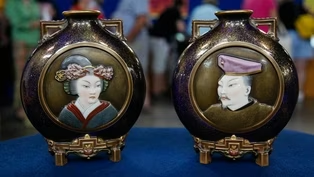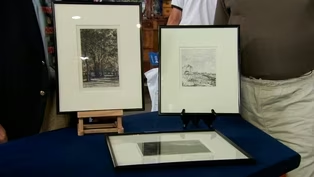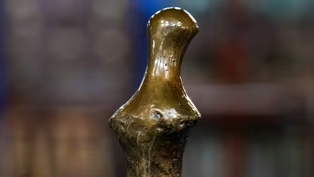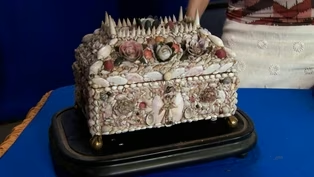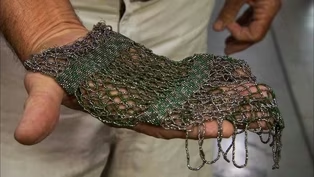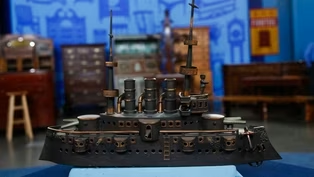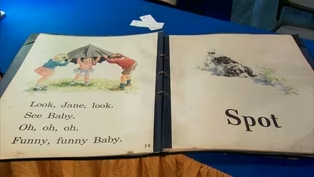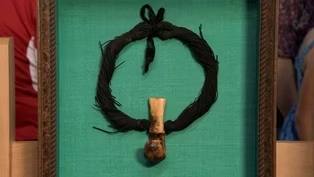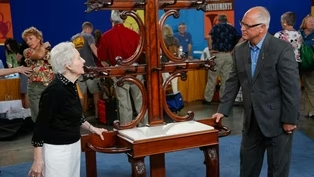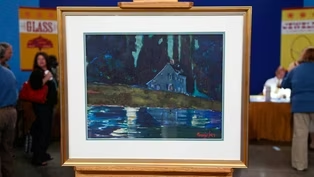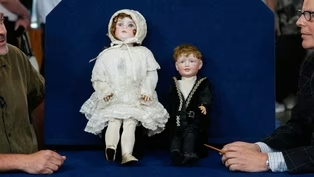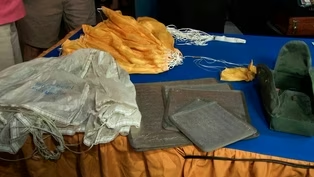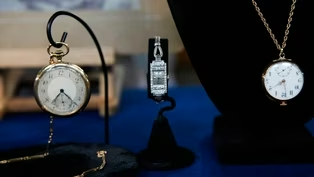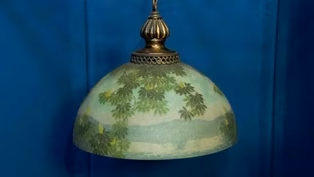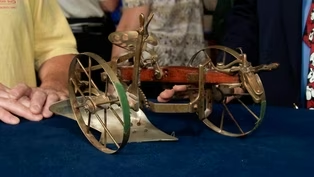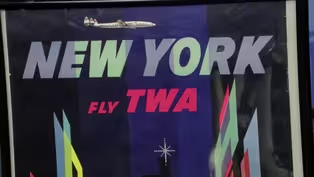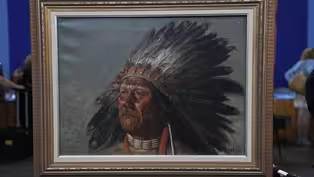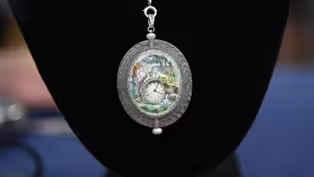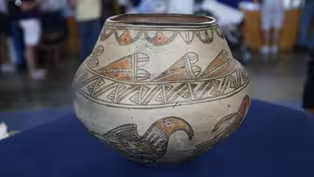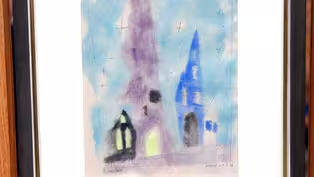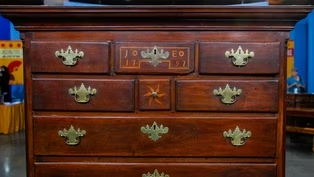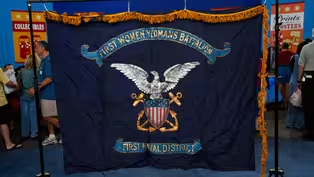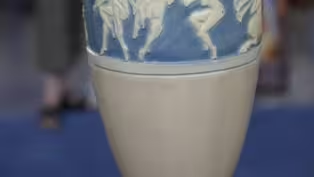
Vintage Phoenix 2025, Hour 2
Season 29 Episode 21 | 52m 25sVideo has Closed Captions
How well will values of discoveries from ROADSHOW’s 2009 visit to Phoenix hold up today?
How well will values of vintage desert discoveries from ROADSHOW’s 2009 Phoenix stop hold up today? Highlights include a 1956 David Klein TWA poster, a 1921 Lyonel Feininger watercolor and an enamel and rock crystal pendant watch, ca. 1910.
Problems playing video? | Closed Captioning Feedback
Problems playing video? | Closed Captioning Feedback
Funding for ANTIQUES ROADSHOW is provided by Ancestry and American Cruise Lines. Additional funding is provided by public television viewers.

Vintage Phoenix 2025, Hour 2
Season 29 Episode 21 | 52m 25sVideo has Closed Captions
How well will values of vintage desert discoveries from ROADSHOW’s 2009 Phoenix stop hold up today? Highlights include a 1956 David Klein TWA poster, a 1921 Lyonel Feininger watercolor and an enamel and rock crystal pendant watch, ca. 1910.
Problems playing video? | Closed Captioning Feedback
How to Watch Antiques Roadshow
Antiques Roadshow is available to stream on pbs.org and the free PBS App, available on iPhone, Apple TV, Android TV, Android smartphones, Amazon Fire TV, Amazon Fire Tablet, Roku, Samsung Smart TV, and Vizio.
Buy Now
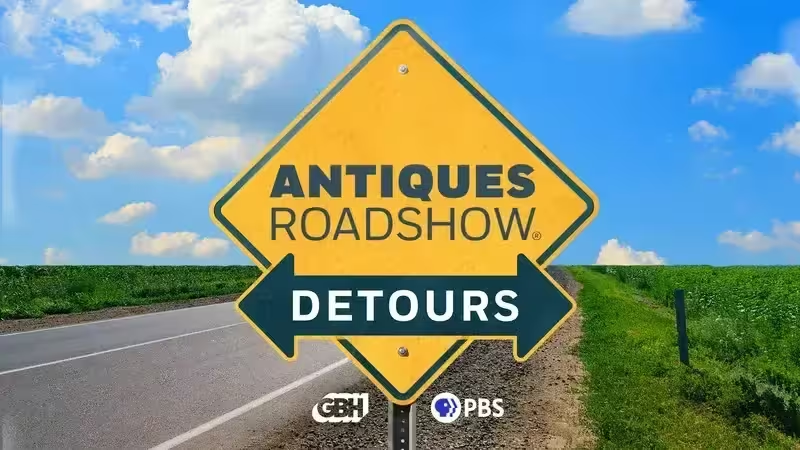
ANTIQUES ROADSHOW DETOURS
Ever wondered what happens to the treasures featured on America’s beloved ANTIQUES ROADSHOW after the cameras leave town? Host Adam Monahan tracks down the juicy afterlives of your favorite finds from PBS’s hit series.Providing Support for PBS.org
Learn Moreabout PBS online sponsorship♪ ♪ If I was this old I'd be having dings and things like this also!
(laughs) What?!
Oh, my gosh, okay!
(laughs) My dad always said, "Be careful with it."
Now I know why!
(laughs) ♪ ♪ CORAL PEÑA: "Roadshow" was on the hunt for treasure in the American Southwest in 2009; discovering cherished heirlooms and valuable gems.
You must be kidding!
APPRAISER: No.
Oh, my God!
PEÑA: Have the values of these prized possessions gone up, down or stayed put?
Find out now, in "Vintage Phoenix," hour two.
GUEST: It was given to me by a friend, he's from the Seattle area.
He was in a little shop and there was a bunch of rolled up posters in a bin.
And, um, he just liked it, probably paid a few dollars for it, and that's really all I know.
So you're asking me to appraise a gift.
I am.
So maybe I could cause some friction between you and your friend, depending on how the appraisal goes.
Actually, he's a very dear friend and a co-worker, and when I was going to bring it, I told him if it was worth much, I'd split it with him.
So I'm saying this on camera.
(laughs) That actually sounds very fair.
The obvious thing is, it's advertising TWA flights to New York City.
The artist signs his name "David," his full name is actually David Klein.
Okay.
And David Klein was a very prolific artist who worked for TWA.
Oh.
This is one of the more recognizable and one of the more popular images that he designed.
Really?
And in my opinion, it is one of the greatest graphic depictions of Times Square.
It's a geometric, abstract, almost kaleidoscopic view... Yes.
...of this great, bustling intersection.
He captures all of the energy, he captures all of the excitement, he captures all of the movement.
It was done in 1956.
It is part silk screen and part photolithograph.
The bright colors have been put on through a silk-screen process... Okay.
...and everything else has been printed via a lithographic process.
One of the other great things about the poster is the plane that's on top.
The plane is the TWA Lockheed Constellation, known as the Connie.
They were considered great airplanes.
Okay.
You see it was a propeller plane.
There's the propellers on it.
Right.
And with these planes, TWA was able to initiate full service to Europe.
Now, I'm not the only one who likes this poster.
The company liked it so much that they continued to reuse it in subsequent years.
But there's one way that we can tell that this is the original printing and not a later printing, and that is the airplane itself.
Because shortly after 1956, propeller planes were phased out and jet planes were phased in.
So subsequent printings of this poster don't show the detailed Constellation.
Oh... They show the silhouette of a jet plane actually leaving a vapor trail behind it as it goes across.
Oh, my goodness.
Not only was the company very fond of this poster, but this poster is also in the permanent collection of the Museum of Modern Art in New York, MoMA.
Really?
So really the poster has a lot of fans.
So it was a gift.
It was a gift.
And I don't want to cause a rift between you and your friend.
(laughs) You couldn't.
But at auction, I would estimate this piece between $2,500 and $3,500.
(gasps) Oh, my gosh!
You're k... Oh, he's going to be so thrilled!
Oh my gosh!
And we have you on camera saying you would split the price with him.
Yes, I told him I would!
GUEST: My uncle had a storage room and he moved out east and he was looking to just get rid of everything in there, and so my brother and I decided to take it and, instead of, you know, getting a few bucks for the whole lot, we would go through it and see what was in there.
Uh-huh.
And we've run across quite a few things, and we ran across a box with some dolls in it.
And as far as what I know about them, uh, I'm about to learn, I guess.
(chuckles) Okay.
I chose two dolls out of the... out of the lot... Yeah.
...just so we could compare the two.
Both of these dolls were made at about the same time, early 20th century, about 1900 to 1910.
The doll in white was made by a company called Armand Marseille, and it sounds like a French name... Yeah.
...but he's a German manufacturer, probably the most prolific doll manufacturer in Germany at the time.
They made these what we call "dolly face" dolls, and they have sleep eyes, an open mouth with teeth showing, and those were all the bells and whistles that people wanted.
This is a great example.
It's got all of its original clothes, original wig.
Thousands and thousands and thousands of this type of doll were made in Germany.
Okay.
About the same time, one of the companies, called Kämmer & Reinhardt, wanted to make some character dolls, something that was a little different than the dolly-face doll.
Mm-hmm.
So they started making this type of doll, and you'll notice it has painted eyes, it has a mouth with painted teeth... People still wanted to buy the doll with the sleep eyes and the open mouth.
The dolls like the doll in black did not sell.
Therefore, it made that doll extremely rare.
Okay.
The artist that designed this doll worked for Kämmer & Reinhardt.
He had a little, uh, tiff with that company.
He moved to the Simon Halbig company in Germany and made this series of dolls.
This particular doll doesn't really have a name, uh, but it's referred to by the number.
It's a Simon & Halbig, 1-5-1, or 151.
The doll in white, made by Armand Marseille, is a number 390.
They're both style numbers for the particular doll.
Okay.
The doll in white, on today's market, retail, would sell for about $450 to $550.
Wow.
The doll in black is going to sell, retail, from between $10,000 and $12,000.
Whoa.
They did a series they called the 100 Series, and there are other dolls in that series that are worth even more than this, but you've got a spectacular doll.
Great.
Thank you.
GUEST: This was in the family and they were among the affluential New England families.
On my great-grandmother's side, they're from the steel manufacturing and mining, and on my great-grandfather's side, a great-great-uncle developed the steam engine.
Wow.
That-that's great stuff.
The chain is all made out of platinum wire with natural pearls, natural meaning man did not help them.
Pearls that you see every day are usually cultured.
He-- Wow, I didn't realize they were pearls.
And then it's accented with these little rose diamond panels.
It's a beautiful, exquisite chain from the Edwardian period, around 1910, 1915.
A chain like that could have been used to hang reading glasses.
So, it could be used for other things.
It drops down to a beautiful rose-cut diamond bail... Uh-huh.
And then we have this beautiful piece of enamel here.
A lot of people look at this and they think it's glass.
What it is, in fact, is carved rock crystal.
Most likely this would have been carved in Idar-Oberstein, Germany.
Then we move in and there's a little bezel of rose diamonds.
And then we come to the enamel.
This is French enamel, and what's really neat is, when we flip it over... ...because it's a lady's pendant watch.
Yes.
These two pearls-- this one here and this one over here-- are natural pearls.
This one is also the stem to set and to wind the watch.
I wondered about that, but I haven't had the courage to mess with it.
(laughing): You didn't try it yet.
Haven't tried it.
They repeat the classical enamel theme in the rose diamonds, but you can see just so tastefully placed a little watch right at the bottom.
And the watch inside is made in Switzerland.
If you had to go buy this in a retail environment, I'm very confident in saying this would probably be priced around $25,000.
Wow.
Wow, that's amazing.
It's the first accurate account of serpents or snakes in India, and it's written by this fellow, Patrick Russell... Mm-hmm.
...who was a Scottish naturalist and surgeon in India.
It's such a beautifully produced book.
It's gone from being a scientific reference work to being a work of art.
Okay.
I would estimate this, at auction, between $3,000 to $5,000.
(chuckling): Oh really?
Really?
Yeah, and I would expect it to do very, very well.
Really?
GUEST: I've inherited it from my great-grandmother, it is a "lei niho palaoa" from Hawaii; it is a symbol of rank and royalty.
It's made of braided human hair and whalebone.
These Hawaiian hooks were generally made out of a sperm whale tooth.
Now, the sperm whales would just be washed up, and that was a pretty rare occurrence, so, anything wonderful like that would only go to the royalty.
And they were small, and sometimes even out of wood and stone in the beginning.
They became more common with the advent of the Europeans, especially with trading.
And we started to see walrus tusks and sperm whale teeth coming from the whalers.
And this one is a walrus tusk.
The braided hair necklace is a little worse for wear, but they're very delicate, and you've done a wonderful thing by putting it in a frame.
It really is an icon of Pacific art.
I'd be comfortable putting an insurance value of about $20,000 on it.
Excellent.
GUEST: I got this in 1982 or 1983 I had just purchased a home, and a friend of mine had gone to England to visit Henry Moore's studio.
He said, "I'd like to give you a house gift."
And I said, "Jeez, that's a little extravagant, isn't it?"
He said, "Well, I only paid 300 bucks each for them, so feel free to pick whichever one you want."
And this is the one I picked.
And I've had it in my home ever since.
The fun part is, is that it came right out of Henry Moore's studio.
Right out of his studio, yes.
Now, Henry Moore is rather an important artist.
He was noted in England for having brought Modernism to Great Britain.
He made monumental sculptures, huge ones that are today out in front of many museums.
This is solid bronze.
It is hand-cast, and the important part of this is that Henry Moore, he did not do the foundry part of the making of it, but he did the hand-finishing of it.
I see.
And so his hand actually touched this piece.
Touched it.
So he did the-the... what is that, a patina?
He did that?
He did the whole patina and the finishing of it.
It's just a small little piece, 6.3 inches I think we measured.
And this is called "Half-Figure: Round Head."
And I think when you came in, you said... I told you "Round Head: Half-Figure," I didn't know.
Well... In fact, I don't know which is the front or the back.
I kind of think this is the front because usually the artist will sign them on the back.
I see.
Now, this is marked "Moore" and then it has the Noack Foundry mark and it says it's number nine of nine.
This is probably going to be worth $15,000 to $20,000.
What?!
Yep, it's worth about 15 to 20... You-you've got to be kidding me, really.
And at auction it could do a little more than double that.
You never know.
My God.
It's a wonderful piece, and what do you think of that?
I thought... first of all, I love the piece.
Secondly, I thought it was maybe worth $800, $900.
I mean I'm... It is absolutely correct.
I am flabbergasted.
It's got all the right markings on it.
That's really wonderful.
So you, you are very lucky to have a Henry Moore that's real in your home.
Well, it's going to stay in my home.
Good.
I'm really surprised at the value, though.
(laughing): That really, really... GUEST: My great-grandfather was friends with George Luks.
They grew up in Pottsville, Pennsylvania.
And George Luks actually gave it to my great-grandfather.
And it's been passed from my grandmother to my father and then to myself.
APPRAISER: Your grandmother, was she from the East or did she move out here?
Yes, she was from Pennsylvania.
And she actually went through a little bit of a rough time and lost everything, and this was the one thing she held on to.
Well, George Luks was quite a character.
George really liked carousing around quite a bit.
Right.
And he was born in Williamsport, Pennsylvania, which is in coal country.
Luks goes on to Philadelphia to study at the Pennsylvania Academy, and of course he goes to Europe, like a lot of the other artists did at the time.
And then he comes back to Philadelphia and works for a newspaper as an illustrator.
He even goes for a while to Cuba for the Spanish-American War and is a war artist over there.
Coming back to Philadelphia, he meets a group of other artists, and they were all newspaper illustrators, but they also were painters.
And they were very rebellious against the prettiness of American Impressionism.
So what they ended up doing was to create their own group.
They were called "The Eight," because there were eight of them, and they were also nicknamed "The Ashcan School" because they liked to paint the back alleys of the city and people hanging wash and the plight, or the day-to-day routine, of-of everyday Americans.
Luks's forte, for the most part, was portraiture, and he painted street urchins and beggar women, rag pickers and basically working-class people.
And he didn't do as many scenes as some of the other artists in the group.
This is a watercolor heightened with a little bit of gouache.
And gouache is sort of the more opaque pigment that you see here.
Mm-hmm.
And most of these were-were done in the 1920s or so.
We see probably half as many Lukses that are fake as are real, and so, there are ways in which we try to authenticate the works by Luks.
There is no real expert on the artist, so usually we're left to our own devices.
But in terms of the watercolors, he normally signs in a very bold red.
I have seen watercolors on occasion with little black, wimpy signatures... (chuckles) ...and they're not, they're not by him.
The bold density of the watercolor and the brushwork-- very characteristic.
And, of course, in your case, it's ironclad provenance, because it came directly from the artist to your family.
So that's really exciting.
Luks actually died in New York in 1933 as a result of a barroom brawl.
He was actually found in a doorstep, uh, dead one night.
Luks is one of the most desirable artists.
If this were sold in a gallery, let's say in New York City, it would probably sell in the range of $75,000.
Oh, my gosh, okay!
(laughs) My dad always said, "Be careful with it."
Now I know why.
(laughs) Wow!
GUEST: My father bought them; he collected Royal Worcester.
And then when my mother passed on, this was one of my picks from her collection because they were on the night table by her bed.
If she had them on her night table, they meant a lot to her, and they must have been good.
They're made of porcelain, and even though they are rather overtly Japanese in their style, they're English-made-- they were made by Royal Worcester.
And Royal Worcester is an old, established English porcelain company.
Royal Worcester is, uh, currently in the process of going out of business after over 250 years of continuous operation-- so it's quite sad.
When these were made by Royal Worcester, they were at a high point in their history in terms of success, uh, commercially, and also in terms of the quality of manufacture.
There's really no one else that it's likely to be except for Royal Worcester.
But we can confirm that by turning over one of them.
And you'll see there's a little printed mark on the bottom.
It's kind of a roundel mark.
And underneath the round is a number 73.
And that's the date-- 1873-- right in the middle of the reign of Queen Victoria.
One of the fashions in 1873, not just in England but also in this country, is what we call Japonisme.
And Japonisme is a French word to describe the Western interpretation of Japanese art and design.
And the art of Japan was somewhat unknown to most Westerners.
It wasn't until just a few years earlier in the late 1860s that the first exhibitions of Japanese art and artistry had been held, uh, in London and Paris.
The shape of them is a traditional Asian form we call a moon flask shape.
But the front panels are decorated to simulate carved and stained ivory, which is a Japanese technique.
And the main ground of the vases is this speckled gilt finish over a deep blue ground that simulates Japanese lacquer.
Both vases have this fabulous flying crane device on the back.
This has all been done in porcelain.
They've got great condition.
I love the form of them, I love the scale of them.
They're just the right sort of size to sit on and decorate a mantelpiece.
I talked with a couple of my colleagues and we felt that the auction estimate would be at least $10,000 and maybe as much as $14,000 or $15,000.
Okay.
Thank you.
That means a lot to me.
GUEST: I was at an auction in Missouri in the early '70s.
They had the hall tree and I thought I would like it.
My husband was standing in the back row, and I could hear him say, "Who in the world would bid on that one?"
And it was me.
(laughter) One of the things I love about this hall tree is the fact that the back is open.
Yes.
Most of the time they have a big mirror on 'em.
In America, the hall tree was introduced a little bit later than it was in England.
Did you know that this was English?
No.
Most people would look at something like this and assume that it would be later in the 19th century, like the 1870s or the 1880s.
But this is actually before 1850.
Oh, it is?
Yeah, it's probably 1830s or '40s, and the reason that I knew that was the overall design, the quality of the carving.
Yeah.
If you look at those toes... Yes.
...and those feet, you know right off the bat that those are hand-carved.
The whole leg is hand-carved... Yes.
...as well as these little foliate decorations right above the knees.
Uh-huh.
You have these great places to put your umbrella when you come in so it doesn't drip on the floor.
The marble top... ...which is, I-I would assume, probably original.
It's got a little bit of wear on it.
Yeah, it's original.
And you've got a drawer here... Yes, it's-- ...that you can put your, uh, put your gloves in.
And one of the characteristics of this that made it English, besides the overall look, was the fact that the secondary wood is very thin compared to what we did in America.
Yeah.
Right.
And also it's mahogany.
And in America, we'd-- we would have used a much softer wood for the secondary wood.
The primary wood on this is walnut.
It's got a few places where it's been repaired... Yes.
O-over the move.
...on the hat rack.
Yeah.
We've moved it several times.
Well, you know what?
That doesn't matter.
It's more important that it's the original hooks.
Well, if I was this old, I'd be having dings and things like this also.
(both laugh) What did you pay for it when you got it at the auction?
About $350.
In my opinion, a good insurance value for this would be $5,000.
Okay, that sounds good.
And if you were to put it in an auction, you want to estimate it $2,000 to $3,000, but I think it could take off up there towards that insurance value.
So, get it insured for about $5,000?
Yeah.
Okay, that sounds good.
APPRAISER: Well, it's what we call a salesman's sample.
And what-- and obviously, it's a plow.
Mm-hmm.
And it's a really complex plow, in a really, very, very fine model.
What can be done here is you changing the pitch depending on the terrain.
So if he's working on a hillside... Right.
...or whatever.
I think, at auction, I would estimate this in the $8,000 to $10,000 range.
Wow.
That's, that's a lot more than I thought!
APPRAISER: This is a photo of your grandfather working in his shop and he was a platinum jeweler.
GUEST: Yes, he was.
Tell us about this great piece.
My grandfather made this platinum glove for my grandmother right after they got married.
Where's the other one?
Well, you know, I don't know.
Uh, my mother, this is all I found that my mother had.
When I was a young child, she showed it to me and she only had one at the time.
So I'm thinking in the 1920s maybe they wore two, maybe they wore one.
We had a Michael Jackson then?
Maybe, I don't know.
(laughs) I just want to let you know that-- it won't fall-- that this is not a glove.
Oh, it's not a glove?
Not a glove.
What is that?
It's a purse.
It's a purse?
And it's damaged up here where the string, the drawstring, and it goes like that.
My goodness.
And they would put a, a colored handkerchief on the inside and change the color all the time.
Wow.
Very interesting.
Now I'm going to sadly tell you the other thing.
Oh, no.
It's not platinum.
Oh, no!
It is cut steel.
Cut steel?
It's made in Germany.
It could have been done in Austria, but in that area.
Right.
1920s.
The flappers wore this down here for a purse.
This is all woven and the women do this.
So your grandfather never made it.
My goodness.
Now, what the condition is-- cut steel today is very nice and it does sell-- it's worth about $350.
Fantastic.
If this was platinum... Right.
we're talking $10,000 to $15,000.
Wow.
GUEST: Our grandpa made experimental, prototype parachutes at Wright-Patterson Air Force Base for about 33 years.
And in the process of that, he got to meet the people who made the spacesuits.
So he made some hot mats out of scraps of material from the early spacesuits.
Now what about these, uh, parachutes?
He made experimental parachutes.
This is a parachute made to bring down a rocket.
This is from the Mercury missions.
This was the prototype that they learned it wouldn't work.
Mm-hmm.
And they had to completely redesign the parachutes for bringing down space capsules.
But they tested these in the wind tunnels, and got the design right with these, before making them bigger.
This one, you'll notice there's no openings in this.
If you're gonna land a parachute on Mars, you have to capture as much of the atmosphere as possible so there's no openings in that.
That's the one that was made to land on Mars.
These parachutes-- they just don't come up, you just don't tend to see them.
So at auction, per parachute, looking at about $2,500 to $3,000 per parachute.
Per parachute.
As far as the pot handles go, maybe $30, $40, for the set.
Yeah, it's what figured.
GUEST: It came from my grandmother's estate in Colorado Springs.
It was passed down to my father.
It was about the only thing that he got from her estate.
I've had it approximately eight years since my father passed away.
I looked up Charles Craig; I believe he was born in Ohio, 1846, somewhere around there.
He traveled to the west, and was a 50-year resident of Colorado Springs, where he painted Indian tribes, and my grandmother probably bought it directly from him.
APPRAISER: Craig was indeed from Ohio.
When he was a very young man, less than 20, he actually traveled west and spent about four years living with various Indian tribes, sketching and learning about their culture.
He was very, very, very fascinated by them and he was something of an adventurer.
To do that, he apparently decided he needed more formal artistic training because he returned east and he studied at several of the more well-known academies.
But did ultimately go back to the west.
He was in New Mexico for a time, he spent most of his career in Colorado Springs.
And he's very typical of one particular branch of the American painting school of the Southwest, because he was quite interested in ethnographic accuracy.
I'd like to find out if we know who this Indian chief is.
The other thing is, there's a few white spots on there.
Are those damage to the canvas or is it paint spackle from my mother?
(laughs) Well, truthfully, I was going to ask you if you knew what those were because they are a little distracting.
Yeah.
I'm not absolutely sure what that is.
My advice to you, because it's such a beautiful painting and it's otherwise in excellent condition, would be to consult with a painting conservator and just ask them to look at those and figure out what's going on.
I'm pretty confident they can be eliminated easily.
As far as the identity of this fellow is concerned, I had a, a really interesting consultation with two of my colleagues.
Craig is most closely identified with the Utes of southwestern Colorado, where he spent a lot of time.
So I thought, logical to think you'd start there.
Apparently not.
My colleagues tell me that this war bonnet is typical of the Plains tribes and probably the Sioux.
Further, that-- the paint he's wearing on his face is not identifiable paint but what we would call personal paint.
He's probably an idealized figure, as opposed to a specific individual.
Okay.
Also, in my experience-- and they've confirmed this for me, too-- if you're dealing with a portrait of a very specific person, they're often inscribed with the name on the back.
As far as the date that this painting might have been done, it's difficult to say, because he did have a 50-year career... Right.
...in Colorado Springs and his subject matter was consistent.
And he died, I believe, in 1930 or somewhere around there... Yes.
...when he was quite an elderly fellow, so I think he could have painted this any time from 1900 into the '20s, certainly.
Yeah.
I think a very fair auction estimate on this painting would be between $5,000 and $7,000.
That might be a little conservative, but I think it's fair.
Okay, that's wonderful.
GUEST: This boat has been in our family for quite a few years.
My great-grandfather worked for Dent Hardware in Allentown, Pennsylvania.
APPRAISER: Okay.
He-- I've been told, made this boat and, uh, several other toys while working at Dent Hardware and he gave this to my grandfather.
Well, Dent Hardware actually started in 1894.
They were a foundry and started in Newark, New Jersey, but shortly after that moved to Fullerton, Pennsylvania, which is right near Allentown.
Oh, okay.
So the factory was actually in Fullerton.
What time period would he have brought this home?
My mother recalls it coming into her home when she was a little girl in the '30s.
It's the Battleship New York.
It reflected a real battleship from that time.
A real ship.
It's made of cast iron.
Not to be a toy for the water, it's actually a floor toy, like a pull toy.
And you can see that by its sheer size, it's a large piece of cast iron.
I mean, this is a heavy boat.
If a child got creative and thought, "Well, let's put it in the water and see what happens," it's going to sink right to the bottom.
(chuckles) So this is a great large, oversized toy for a cast iron manufacturer.
Now, the typical New York battleship is painted.
And this toy obviously is not painted, it's plated.
We call this "copper flash."
Now, this is something that they did a lot on some of the other toys they made, but you don't see it very often on the battleship.
There's so many pieces to it.
These masts remove.
All these guns-- which, by the way, are nickel-plated cast iron, they remove.
Oh... And also we have the anchors up there, there's two of them.
And we're showing one that has a little damage.
To show action, it had a off-center front wheel.
It doesn't work very well, because it hasn't been cooperating with us... (chuckles) ...but I'm going to push it and show you.
You'll watch the front end drop down, and it simulates water.
Yes.
A retail price would be in the area of $4,000 to $5,000.
Really?
Yeah.
Yeah.
Oh, that's exciting.
Some of these boats have sold for more, painted.
There's a possibility that if the right collectors really felt that this was superior in rarity and finish, it might bring more.
But it's hard to say, because I've never really seen a copper flash version sell to the market.
So I think it's a good, conservative estimate.
I'm just thrilled.
(chuckles) GUEST: My first tour in the Navy, I was an ensign, I went to my first command, the building we were in they were renovating, so they called us and said, "You have some trash here, come get rid of it."
I sent my sailors over to throw the stuff away.
They saw this flag, it says "women" on it, I'm a woman, so they brought it to me.
(chuckling) And I carted it around for the rest of my 26 years in the Navy.
I know women were in the Navy in 1917.
There were 600.
A year later, there was 11,000 women.
And they did yeoman jobs, which is clerical work.
Clerks and accountants and things like that.
Absolutely.
And you mentioned, in 1917-- which is interesting, because at the time, the secretary of the Navy saw the term yeoman and said, "It doesn't just mean 'man.'"
Right.
They needed every able-bodied person they could.
Correct.
So they brought the women in to do yeoman's work, which a lot of folks don't know that women were there during the First World War.
That's right.
And this is a First World War period flag.
It's silk with hand-painted emblems on it.
Okay.
The First Naval District was at Portsmouth, New Hampshire, late, later Boston.
It started in Portsmouth in the, in 1903, went to Boston about mid-'40s.
The great thing about this flag is that it shows the kind of patriotic nature that-that the women must have had at the time in order to really gear them up to be a part of the service.
In the center we have the U.S.
Naval insignia, which is still in use today on officer's cap badges, the eagle over the shield over the crossed anchors.
Now, I couldn't find out too much about the Women's Battalion either, but we still know that women were in service during the First World War and they did do a lot of yeoman's work.
It may have even been done by the women themselves as something that they wanted to use to-to inspire the rest of the women in the battalion.
And maybe they had it on base as an unofficial flag.
Is it something that a museum, a Navy museum or women-in-the-military museum, might be interested in having?
If you think you're going to keep it, it's worthy of conservation.
If you're going to donate it, the best thing to do is really let the institution decide how to handle the conservation.
Okay.
Because it's going to need to be cleaned, going to need to address these issues where it's starting to split, because the weight of the banner itself is pulling it apart.
So it depends on what you want to do.
But there's no doubt that interest in women in the service has grown over the years.
There'd be many institutions that would love to have this banner.
In this condition, I would say it's around $1,500, maybe $2,500.
Okay.
Fixed up would certainly enhance the value, but that would be a costly undertaking, so you really have to decide, "do I want to own it "or do I want to give it to somebody who could display it?"
GUEST: This pot came from an estate of some very wealthy people back east.
And it ended up with my mother, is how it happened.
She-she was married to one of the heirs of the estate and then he inherited the pot and it just sat in her house.
Do you know about the potter Maria Martinez at San Ildefonso Pueblo in New Mexico?
The black pottery?
She is the famous potter in the American Indian world.
Maria Martinez started making pots around the turn of the century, 1900, 1910.
And everybody thinks that all the pottery from San Ildefonso is black on black.
This is a San Ildefonso pot from the 19th century.
It kind of has a gray background, sort of a grayish color.
And it has these incredible birds on it that go all the way around it, and these abstract designs.
The color's real soft.
The slip on it's a little bit weak almost.
It's a very soft sort of look and color to it.
Now, we turned it over, and in very weak letters here, it says San Ildefonso.
And then there's a name underneath it, "Montoya."
Maria learned to make pots from lots of people.
This pot was made by Florentino Montoya, one of her teachers.
Montoya's wife's name was Martina Vigil.
And Vigil and Montoya started making pots at San Ildefonso probably about 1875.
So this is probably, because of the gray slip on the background, one of the earlier San Ildefonso pots that anybody's seen that is identifiable.
The fact that it's signed is remarkable.
This is a pre-Maria pot that traces the whole tradition that went to her and the great art pots that she did in the 20th century.
Now, you had an appraisal.
It was done in the '80s and it was like $1,250?
We've only seen one or two of these pots ever come up for sale.
They're extremely rare.
We've never seen a signed one come up for sale.
On a bad day in a nice gallery, $25,000 for this pot.
Wow.
Wow.
It could go double that.
It could go $40,000 or $50,000.
Oh, my God.
It's a great thing.
It is a very great piece of art.
Okay, thank you.
Thank you for coming.
Thank you for telling me that, that's just great news.
APPRAISER: What you've brought us today is the teacher's edition of "Dick and Jane."
We've got, uh, of course, the gigantic star of the series... (chuckles) ...along with his companion, Jane.
We don't want to forget their ever-faithful dog, Spot.
(laughing): Spot.
These giant editions from the 1940s to the '60s routinely sell in the $500 to $600 range.
(laughing): Ooh!
Well, that's good, 'cause my mom has another one, so... (both laugh) That's cool, thank you.
GUEST: Well, I was looking about 40 years ago for some art to put up in our first apartment.
My wife and I were married, and we decided we would like to get something original instead of a print.
Okay.
And I happened upon these in a garage shop in Lakewood, Ohio.
Okay, and about what did you pay for each one?
Well, they were 50 cents apiece.
50 cents apiece.
Yes, sir.
Well, I think you did fine.
Oh, that's good.
Uh, you have two 19th century etchings by well-listed artists, and one 18th century etching.
The 18th century one is by an artist by the name of Canaletto.
Major 18th century Italian painter, did a small number of etchings.
Rough value, probably somewhere in the neighborhood of $750.
A very nice piece for, for 50 cents.
Yes.
Samuel Palmer-- early 19th century, mid-19th century English painter and printmaker.
General values on his pieces is in a similar ballpark-- $750 to $1,000.
And the last one is by Seymour Haden.
The etching value is probably somewhere in the $300 to $400 range.
Thank you very much.
GUEST: It was given to me by my aunt, who was 93 years old when she gave it to me.
And she had received it from her aunt when she was probably in her mid-20s, in Ohio.
What you have here is a really exciting piece of Roseville pottery.
It's an experimental piece of Roseville pottery.
And for people who collect Roseville, experimental is great.
Roseville, which was such a large company, started out in Roseville and then moved to Zanesville, Ohio.
Mm-hmm.
Now, when I picked this up, I recognized the feel of it.
The clay body and the line of this blank they did most of their experimental works with, which is called Rosecraft Vintage, and it was introduced in 1925.
But this decoration here is probably unique.
This glaze color is highly unusual.
And this whole bacchanal scene-- which is, by the way, pretty racy-- is not on any other pot of theirs.
And the reason they did not produce this piece... Mm-hmm.
It may have been too complicated... Okay.
...too many colors, who knows, or perhaps the dancing naked ladies?
Mm-hmm.
That may have been a problem for some.
Okay.
This one, being experimental, is probably all hand-carved.
Mm-hmm.
Which you don't see in regular Roseville, which is molded.
Part of the fun thing of finding an experimental piece is when you see on the bottom, instead of a signature, you see all the glaze numbering.
They very carefully describe where specific glazes will go.
So this is fabulous.
Oh!
There are fewer Roseville collectors today than there used to be 20 years ago.
A very conservative amount at auction is $3,500 to $4,500.
Oh, wow.
A good insurance value, probably in the $5,000 to $6,000 range.
Oh, wonderful.
GUEST: My mother gave me this in the mid-'70s.
I had been living in Africa, and I came back and had no furniture.
She gave it to me as I was trying to furnish a house.
My sister tells me that she gave it to me because it says "Joe" on there.
Someone gave it to her in Phoenix, and I do not know who gave it to her.
Once I was told that it was from Pennsylvania.
I was also told that the J-O and E-O may be initials of a couple that was getting married... Right.
...and that it was a marriage chest.
Exactly, exactly.
And obviously, the date speaks for itself.
It's a Chippendale, Chester County, Pennsylvania, tall chest.
So, Chester County was about 25 miles from Philadelphia.
Right.
So the cabinetmakers there were working in roughly a Philadelphia style, but doing their own thing.
There are distinctive things that are Chester County, Pennsylvania, about this.
By 1797, there were Anglo settlers from England, there were Welsh settlers, and there were German settlers.
So these pieces have a combination of all three of those immigrants' work.
At the top we have this ogee molding.
Right.
And then J-O and E-O.
The brasses flanking are Chippendale brasses that are original brasses.
We go down, and the pair of drawers flanking this wonderful drawer.
This bottom drawer is massive.
Here are these classic Chester County feet with these big spurs here, these wonderful, large ogee feet.
And look at the surface on that, the color of the wood.
The thing that I think is really neat about this that you know about, I know, is this drawer, right?
Right.
And originally, this did not have a knob.
That was a decorative panel.
There's no marks around it from where people pulled it.
It looked like a decorative panel.
Oh, okay.
So you unlock this drawer, you pull it out, you slip inside, push that hole... Right.
And lo and behold, you open it up, and here is the spring lock right here... Yeah.
...that held that in.
That was the only way you could get it open, is to open this drawer and go up.
So, here, we have a shallow drawer and this really neat hidden drawer.
Now, this poplar on that drawer is over 200 years old, and it smells like it was cut yesterday.
You can smell that wood.
Yeah.
Doesn't that smell like fresh-cut wood?
The wood is walnut, which was a locally grown wood, American black walnut.
And that is holly wood-- it's H-O-L-L-Y.
It's a light wood, and they used it because it contrasted with the walnut.
That was really popular in Chester County, which is known for inlaid furniture.
The black, I think it could be an ebony.
This piece, because of all the great things it has-- would be estimated conservatively at auction at $20,000 to $30,000 on it.
(chuckling): Wow.
I mean, and that's a conservative estimate.
Because of all those things, it could bring much more than that.
That's nice!
GUEST: The photograph was taken around 1890 to 1900, and it's of the jewelry store in Nordmaling, Sweden.
And they moved from Sweden to America?
Yes, they came in two waves.
Did they remain in the jewelry industry, or watch industry?
Oh, absolutely.
All my uncles were watchmakers, and they worked in repair shops in Chicago, Illinois.
Well, why don't you go through and explain what you know about the watches, then.
The first one over here on the gold chain necklace, that belonged to my grandmother, and it looks upside down, but for the woman who wears it, then she can lift it up and it's in a correct position so she can tell the time.
This pocket watch belonged to my Uncle Gustin.
And, uh, it's a very thin piece, but it fit very easily into a pocket and didn't create too many lumps.
The other, uh, watch here belonged to my Aunt Ebba, and it's made of some kind of a platinum material, and it's very much a dress-type watch.
It's not an everyday type of watch.
And have you done any research in terms of their-their value or the makers, et cetera?
Well, I was offered about $1,000 for that wristwatch at one time.
These others, I've no idea what they're worth.
Starting with the little lady's watch here, it's Swiss made, it's in a 14 karat gold case.
Now, although it's hanging upside down like this, it's actually been converted.
And it would have been made with a bow on one side and a clip on the other side.
Made around the 1900, 1910 era.
Mm-hmm.
One of the very first types of wristwatch.
And now, when wristwatches were first being made, their manufacturers didn't want to change their-their manufacturing techniques... I see.
So they simply added this little clip on the reverse side.
I see.
And that way you could strap it to your wrist.
Huh.
Probably converted in the 1920s, by the look of it.
It's not made by a known manufacturer, and realistically today, it's worth its gold value.
Oh, really?
It's around a hundred-dollar watch.
Really?
Okay.
I'm-I'm surprised, but okay.
The men's pocket watch, uh, again in 14 karat gold, again Swiss, made in the 1920s, very classic with this style of Breguet numerals, as they're called.
Mm.
Uh, the chain also dating to the 1920s, also in 14 karat gold.
It-it is much slimmer than you normally find.
Again, an unsigned, very nice quality, but, but not by, by any manufacturer of a known quality.
Mm-hmm.
It's worth slightly more than its gold value.
You'd probably be looking at around $300.
Okay.
This is for auction purposes.
For the lady's wristwatch in the center, it's late 1920s, early 1930s.
Right.
Very typical cocktail watch of the era.
Retailed by Spaulding and Co.
in Chicago.
Mm-hmm.
And I'm pleased that you didn't sell it.
This, I think, is a classic case of, if someone offers to buy something... Yeah.
...always ask for a second opinion.
Right.
Very much so.
Never necessarily take the first one.
Oh, absolutely, I agree.
The reason being, it's actually-- it's made by a very well-known Swiss company called Patek Philippe.
Ah, yes.
Patek Philippe are one of the most famous and also one of the highest quality... Yes.
...uh, Swiss brands.
It's made in platinum with a platinum band, and the case is also set with diamonds.
Now, the-the case itself is-is not signed Patek Philippe, but this was not that uncommon of the era.
Mm-hmm.
They would supply movements to-to very high-quality retail outlets such as Spaulding and Co., and this, as a realistic auction value, is worth $5,000.
Oh, how nice.
So I'm very pleased you didn't take the thousand-dollar offer.
(chuckling): Me, too-- right.
GUEST: It was a present from my father.
I inherited it from him when he passed away.
I always liked Lyonel Feininger.
I had a book about him, and, uh, I've seen pictures in museums of him, and, uh, I was thrilled when I inherited the painting.
I came to this country a long time ago for one year, and my dad visited me and we went to the Metropolitan Museum of Art and there was this picture of Lyonel Feininger.
He did a lot of churches.
And, uh, I liked it and he bought a poster and framed it for me.
That was the first picture I ever owned.
And how did that poster compare to this work?
I like the poster better.
(laughs) Because it was a picture of the oil painting.
This is just a sketch.
I like it very much, don't get me wrong.
Well, the picture is signed down here, lower left, as we can clearly see.
And it's also dated.
This translates to "Thursday, the tenth day of February, 1921."
Mm-hmm.
And the work is a watercolor.
The title on the back... tell me in German?
It's, uh, "Silberne Sterne," which means "silver stars" in English.
So you can see here that the stars have been reduced to these kind of cross-like, or X-like shapes.
And Feininger's style, he would reduce his subjects to very simple shapes or planes, and then combine them with this linear definition.
Very interesting artist.
He was born in New York in 1871 to parents who were both musicians.
And they fully expected him to study music, but he decided he wanted to study art, and he went off and studied in Paris and Germany.
And in 1919, he was asked to teach at the Bauhaus, which is a very famous school of art, craft, design.
Very influential in the Modernist art world.
And then he had to come back to the States when the Nazis took over Germany.
This really is a wonderful work.
The colors are so great.
I love the colors, I love the colors.
He manages to make his works a little bit of realism but a lot of fantasy, and they're just very, very appealing.
I think if this were offered in a retail gallery, it might sell for as much as $75,000.
You must be kidding.
(chuckling): No.
Oh, my God.
It's a lovely example.
Oh, my God, I had no idea.
(sighs, laughs) I thought maybe $5,000, $8,000, something like that.
Thank you so much.
PEÑA: And now it's time for the "Roadshow" Feedback Booth.
We took this, uh, painting that's been in the family for a really long time to the "Antiques Roadshow" today.
We thought we might be able to find out if we were finally going to be able to throw it in the garbage, and it turns out it's worth $2,500 to $5,000.
(laughs) Thank you, "Antiques Roadshow."
Yeah.
I brought in this picture of, uh, Gene Cernan, the last man on the moon, and, uh, I was quite surprised, they appraised it for, like, $3,000 and going up.
And this picture that I paid $1.50 for is worth $200 to $300.
And she'll definitely be dragging me more to garage sales all the time now.
And I got this from my grandmother.
It's the only thing I've had from my grandmother.
I thought it might be an antique, but they said it's from the '50s.
I'm from the '50s, so that means neither one of us is an antique, and I guess that's good news.
(laughs) Brought some of my Bakelite and I got to meet a lot of the appraisers.
It was awesome.
So, uh, my husband at home, they tell me that if I get hit by a bus tomorrow, these should not go in the alley.
Thanks.
And our ex-husband's mother gave me this pin... And our ex-husband gave me this antique hymnal.
To bring to... So we came to the "Antiques Roadshow" together to get them appraised.
Yay, "Antiques Roadshow"!
PEÑA: Thanks for watching.
See you next time on "Antiques Roadshow."
Appraisal: 1799 Patrick Russell Indian Serpents Book
Video has Closed Captions
Clip: S29 Ep21 | 32s | Appraisal: 1799 Patrick Russell Indian Serpents Book (32s)
Appraisal: 1873 Royal Worcester Japonisme Flask Vases
Video has Closed Captions
Clip: S29 Ep21 | 3m 2s | Appraisal: 1873 Royal Worcester Japonisme Flask Vases (3m 2s)
Appraisal: 18th & 19th C. Etchings
Video has Closed Captions
Clip: S29 Ep21 | 1m 16s | Appraisal: 18th & 19th C. Etchings (1m 16s)
Appraisal: 1982 Henry Moore "Half-Figure: Round Head" Bronze
Video has Closed Captions
Clip: S29 Ep21 | 2m 39s | Appraisal: 1982 Henry Moore "Half-Figure: Round Head" Bronze (2m 39s)
Appraisal: 19th C. Shell-encrusted Casket
Video has Closed Captions
Clip: S29 Ep21 | 34s | Appraisal: 19th C. Shell-encrusted Casket (34s)
Appraisal: Cut Steel Handbag, ca. 1920
Video has Closed Captions
Clip: S29 Ep21 | 1m 49s | Appraisal: Cut Steel Handbag, ca. 1920 (1m 49s)
Appraisal: Dent Hardware Toy Battleship, ca. 1920
Video has Closed Captions
Clip: S29 Ep21 | 2m 48s | Appraisal: Dent Hardware Toy Battleship, ca. 1920 (2m 48s)
Appraisal: "Dick and Jane" Teacher's Edition Book, ca. 1950
Video has Closed Captions
Clip: S29 Ep21 | 38s | Appraisal: "Dick and Jane" Teacher's Edition Book, ca. 1950 (38s)
Appraisal: Early 19th C. Hawaiian Lei Niho Palaoa
Video has Closed Captions
Clip: S29 Ep21 | 1m 14s | Appraisal: Early 19th C. Hawaiian Lei Niho Palaoa (1m 14s)
Appraisal: English Regency Hall Tree, ca. 1840
Video has Closed Captions
Clip: S29 Ep21 | 3m 1s | Appraisal: English Regency Hall Tree, ca. 1840 (3m 1s)
Appraisal: George Luks Watercolor, ca. 1925
Video has Closed Captions
Clip: S29 Ep21 | 3m 14s | Appraisal: George Luks Watercolor, ca. 1925 (3m 14s)
Appraisal: German Dolls in Original Clothes, ca. 1905
Video has Closed Captions
Clip: S29 Ep21 | 2m 57s | Appraisal: German Dolls in Original Clothes, ca. 1905 (2m 57s)
Appraisal: NASA Parachutes & Pot Handles, ca. 1965
Video has Closed Captions
Clip: S29 Ep21 | 1m 20s | Appraisal: NASA Parachutes & Pot Handles, ca. 1965 (1m 20s)
Appraisal: Patek Philippe & Swiss Watch Collection
Video has Closed Captions
Clip: S29 Ep21 | 3m 48s | Appraisal: Patek Philippe & Swiss Watch Collection (3m 48s)
Appraisal: Reverse-painted Handel Shade, ca. 1920
Video has Closed Captions
Clip: S29 Ep21 | 1m 4s | Appraisal: Reverse-painted Handel Shade, ca. 1920 (1m 4s)
Appraisal: Salesman's Sample Plow, ca. 1880
Video has Closed Captions
Clip: S29 Ep21 | 35s | Appraisal: Salesman's Sample Plow, ca. 1880 (35s)
Appraisal: 1956 David Klein TWA Poster
Video has Closed Captions
Clip: S29 Ep21 | 2m 59s | Appraisal: 1956 David Klein TWA Poster (2m 59s)
Appraisal: Charles Craig Oil Portrait, ca. 1910
Video has Closed Captions
Clip: S29 Ep21 | 3m 30s | Appraisal: Charles Craig Oil Portrait, ca. 1910 (3m 30s)
Appraisal: Enamel & Rock Crystal Pendant Watch, ca. 1910
Video has Closed Captions
Clip: S29 Ep21 | 2m 10s | Appraisal: Enamel & Rock Crystal Pendant Watch, ca. 1910 (2m 10s)
Appraisal: Montoya & Vigil San Ildefonso Pueblo Pot, ca. 1880
Video has Closed Captions
Clip: S29 Ep21 | 2m 54s | Appraisal: Montoya & Vigil San Ildefonso Pueblo Pot, ca. 1880 (2m 54s)
Appraisal: 1921 Lyonel Feininger "Silver Stars" Watercolor
Video has Closed Captions
Clip: S29 Ep21 | 2m 50s | Appraisal: 1921 Lyonel Feininger "Silver Stars" Watercolor (2m 50s)
Appraisal: 1797 Chester County Marriage Chest
Video has Closed Captions
Clip: S29 Ep21 | 3m 8s | Appraisal: 1797 Chester County Marriage Chest (3m 8s)
Appraisal: 1917 First Women Yeomen's Battalion Flag
Video has Closed Captions
Clip: S29 Ep21 | 2m 47s | Appraisal: 1917 First Women Yeomen's Battalion Flag (2m 47s)
Appraisal: Roseville Experimental Vase, ca. 1925
Video has Closed Captions
Clip: S29 Ep21 | 2m 9s | Appraisal: Roseville Experimental Vase, ca. 1925 (2m 9s)
Providing Support for PBS.org
Learn Moreabout PBS online sponsorship
- Home and How To

Hit the road in a classic car for a tour through Great Britain with two antiques experts.













Support for PBS provided by:
Funding for ANTIQUES ROADSHOW is provided by Ancestry and American Cruise Lines. Additional funding is provided by public television viewers.


